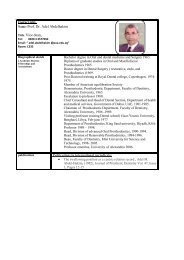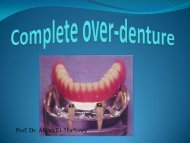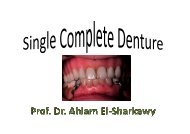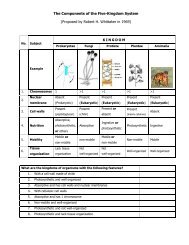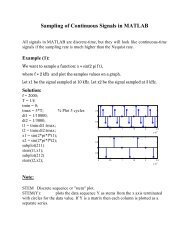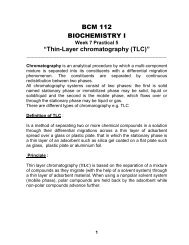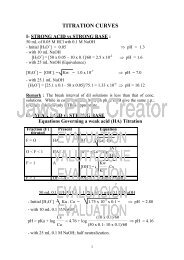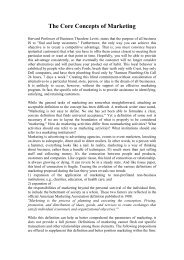PHR 326_ Oil Analysis-Power Point--
PHR 326_ Oil Analysis-Power Point--
PHR 326_ Oil Analysis-Power Point--
You also want an ePaper? Increase the reach of your titles
YUMPU automatically turns print PDFs into web optimized ePapers that Google loves.
Prof. MOHAMMED HAFIZ<br />
12/10/2012 1<br />
PDF created with pdfFactory Pro trial version www.pdffactory.com
Chemical structure of lipids<br />
Lipid is an ester of fatty acid and alcohol.<br />
If glycerol is alcohol the ester is known as<br />
triglyceride which almost constitutes oils and fats<br />
(LIPIDS).<br />
If alcohol is a long chain of high molecular weight<br />
monohydroxy alcohol the ester is known as wax<br />
e.g., beeswax. CH 2 - OCOR 1<br />
R 2OCO<br />
C<br />
*<br />
H<br />
CH 2 - OCOR 3<br />
oils and fats<br />
CH 3 - (CH 2) 12 - OCO - (CH 2) 14 - CH 3<br />
beewax<br />
12/10/2012 2<br />
PDF created with pdfFactory Pro trial version www.pdffactory.com
Composition of lipids<br />
Lipid is a solution, its solvent is the glycerides<br />
(saponifiable part) and its solute is non-glycerides (nonsaponifiable<br />
part).<br />
1) Non-saponifiables (or Unsaponifiables)<br />
It is that part of lipid which is not affected by<br />
alkali-hydroxides during saponificaiton of lipid and can be<br />
extracted by organic solvents after saponifcation (as<br />
vitamins, sterols and resins). They are non-volatile on<br />
drying at 80 o C. It rarely exceeds 2%.<br />
2) Saponifiable part (glyceride part)<br />
They are esters of fatty acids and glycerol which<br />
upon saponification with alkali gives glycerol and alkali salt of<br />
fatty acids (soap). It is the major part of lipid as it<br />
constitutes about 99% of lipid. Therefore the chemical and<br />
physical properties of lipids vary with variations of the<br />
glyceride part (fatty acid composition).<br />
12/10/2012 3<br />
PDF created with pdfFactory Pro trial version www.pdffactory.com
Glycerides<br />
Fats and oils are ESTERS of glycerol and<br />
long chain carboxylic acids<br />
Glycerides<br />
12/10/2012 4<br />
PDF created with pdfFactory Pro trial version www.pdffactory.com
Saponifiable<br />
Part(Glyceride)<br />
12/10/2012 5<br />
PDF created with pdfFactory Pro trial version www.pdffactory.com
Saponifiable<br />
Part(Glyceride)<br />
Triglycerides may be:<br />
-Simple glycerides: the same fatty acid<br />
radicals<br />
-Mixed glycerides: different fatty acid<br />
radicals<br />
12/10/2012 6<br />
PDF created with pdfFactory Pro trial version www.pdffactory.com
Composition of lipids<br />
2) Saponifiable part (glyceride part)<br />
CH 2 OCOR CH 2 OH<br />
heat<br />
CHOCOR + KOH CHOH + 3 RCOOK<br />
CH 2 OCOR CH 2 OH<br />
Glycerol<br />
Immiscible with Miscible with<br />
aqueous solution aqueous solution<br />
Soap<br />
12/10/2012 7<br />
PDF created with pdfFactory Pro trial version www.pdffactory.com
I- Physical examination<br />
vDetermination of water<br />
The moisture content of oils and fats is determined by Karl-<br />
Fischer reagent.<br />
vMelting point (M.P.)<br />
Melting point of lipid is directly proportional to the chain<br />
length of fatty acids and inversely proportional to the number<br />
of double bonds.<br />
vSpecific gravity<br />
weight of certain volume of oil<br />
Specific gravity (Sp.gr.) =<br />
weight of the same volume of water<br />
12/10/2012 8<br />
PDF created with pdfFactory Pro trial version www.pdffactory.com
II- II Chemical Examination<br />
The chemical examinations of lipids involve<br />
reactions with ester linkage of the glycerides or<br />
free carboxylic acid, hydroxyl group of hydroxyl<br />
acids as well as the double bonds of the<br />
hydrocarbon chain of fatty acids, in order to<br />
differentiate between the different types of<br />
lipids, through determination of some chemical<br />
constants.<br />
12/10/2012 9<br />
PDF created with pdfFactory Pro trial version www.pdffactory.com
Acid value<br />
The acid value, AV, is the number of milligrams of<br />
KOH required to neutralize the free fatty acids (FFA)<br />
present in 1 g of the substance.<br />
Determination<br />
Dissolve the substance examined in ethanol/ether 1:1,<br />
titrate against 0.1M KOH, ph.ph. indicator<br />
mL KOH×M× 56<br />
Acid value = ______________<br />
sample wt in gm<br />
-Edible oil contain > 1%<br />
-Pharmaceutical oil must not have any acidity.<br />
12/10/2012 10<br />
PDF created with pdfFactory Pro trial version www.pdffactory.com
Acid value<br />
Significance<br />
Acid value is the measure of<br />
hydrolytic rancidity (action of lipase on<br />
triglycerides to give FFA). In general, it<br />
gives an indication about freshness and<br />
edibility of the lipid<br />
12/10/2012 11<br />
PDF created with pdfFactory Pro trial version www.pdffactory.com
The saponifcation value is the number of mg of KOH<br />
required to neutralize the free fatty acids and to<br />
saponify the esters in 1 g of the substance.<br />
SPV = FFA+combined FA<br />
Saponification value<br />
Determination<br />
A certain weight of the substance is refluxed with<br />
known volume of 0.5M ethanolic KOH, then the excess<br />
unreacted 0.5M KOH is titrated against 0.5 M HCl,<br />
using ph.ph. indicator.<br />
(Total – e.p.) ×M×56<br />
Saponifcation value = _______________________<br />
sample wt in gm<br />
12/10/2012 12<br />
PDF created with pdfFactory Pro trial version www.pdffactory.com
Saponification value<br />
Significance<br />
Saponification value is inversely proportional to the<br />
mean molecular weight of fatty acids (or chain length).<br />
S.V. of butter fat and vegetable fats ~ 220 – 250<br />
S.V. of fixed oils (vegetable oils) ~ 195<br />
12/10/2012 13<br />
PDF created with pdfFactory Pro trial version www.pdffactory.com
Ester value<br />
The ester value is the number of milligrams<br />
of KOH required to saponify the esters present in<br />
1 g of the substance.<br />
It is calculated from the saponification value and<br />
the acid value<br />
Ester value = saponification value (SPV)-Acid value (AV)<br />
12/10/2012 14<br />
PDF created with pdfFactory Pro trial version www.pdffactory.com
Acetyl value<br />
It is the number of mg KOH required to neutralize the<br />
acetic acid liberated by the hydrolysis of one g of<br />
acetylated oil.<br />
Determination<br />
non acetylated oil determine its SPV<br />
<strong>Oil</strong> sample<br />
+(CH 3 CO) 2 O acetylated oil +CH 3 COOH<br />
determine its SPV<br />
Acetyl value=SPV of acetylated part-SPV of non<br />
acetylated part<br />
12/10/2012 15<br />
PDF created with pdfFactory Pro trial version www.pdffactory.com
Significance<br />
Acetyl value<br />
Acetyl value is the measure of hydroxy acids<br />
in lipids.<br />
Acetyl value of castor oil (Recin oil) = 150,<br />
because it is rich in recinoleic acid.<br />
Acetyl value of <strong>Oil</strong>s containing no hydroxyl<br />
fatty acids = 5-15<br />
Oxidative rancidity formation of hydroxy<br />
acids rise acetyl value<br />
12/10/2012 16<br />
PDF created with pdfFactory Pro trial version www.pdffactory.com
Iodine value I.V.<br />
It is the number of parts of I 2 absorbed by 100<br />
parts of lipid by weight. (1gm of fat absorbed<br />
1.5 gm I 2 , I.V.=150)<br />
The following reagents can be used as halogenating<br />
agents during the determination of I.V.<br />
Halogenating agent Composition Time of addition<br />
1) Wij's reagent I 2 /Cl 2<br />
2) Hanus reagent I 2 /Br 2<br />
in gl. acetic acid 30-60 minutes<br />
in gl. acetic acid 60-120 minutes<br />
12/10/2012 17<br />
PDF created with pdfFactory Pro trial version www.pdffactory.com
Determination<br />
Iodine value I.V.<br />
Take a certain weight of substance examined,<br />
dissolve in organic solvent, add known volume of<br />
halogenating agent, keep in dark for 60 min. Add<br />
KI solution and titrate the libarated I 2against<br />
st. Na 2S 2O 3<br />
IBr + KI I 2 + KBr<br />
I 2 + 2Na 2 S 2 O 3 2I - + 2Na 2 S 4 O 6<br />
12/10/2012 18<br />
PDF created with pdfFactory Pro trial version www.pdffactory.com
vSignificance<br />
I.V. is the measure of the degree of<br />
unsaturation of fatty acids composing the<br />
glycerides of oils or fats.<br />
I.V. is directly proportional to the degree of<br />
unsaturation (No of d.b.) and inversely proportional<br />
to the melting point (m.p.) of lipid. An increase in<br />
I.V. indicates high susceptibility of lipid to<br />
oxidative rancidity due to high degree of<br />
unsaturation.<br />
1<br />
I.V. a No of d.b a ________ Iodine value I.V.<br />
a succeptibility to<br />
M.P. oxidative rancidity<br />
12/10/2012 19<br />
PDF created with pdfFactory Pro trial version www.pdffactory.com
Iodine value I.V.<br />
According to I.V. oils can be classified into<br />
the following classes:<br />
Class I.V. The main<br />
1- Non-drying<br />
oils<br />
2- Semidrying<br />
oils<br />
unsaturated acid<br />
Examples<br />
80-100 Oleic acid (C 18:1) Olive oil, Castor oil,<br />
almond oil<br />
100-140 Linoleic (C 18:2) Cottton seed oil,<br />
sesame oil<br />
3- Drying oils 140-200 Linolenic (C 18:3) Linseed oil,<br />
Fish oil, sunflower oil<br />
12/10/2012 20<br />
PDF created with pdfFactory Pro trial version www.pdffactory.com
Rancidity is a process which is accompanied<br />
by the formation of unpleasant odour,<br />
taste, as a result of the action of<br />
moisture, air (O 2 ) and enzymes<br />
Types of rancidity<br />
1- Hydrolytic rancidity (lipolytic rancidity)<br />
2- Oxidative rancidity<br />
12/10/2012 21<br />
PDF created with pdfFactory Pro trial version www.pdffactory.com
1- hydrolytic (lipolytic) rancidity<br />
T.G. Moisture<br />
Lipase<br />
1,2-diglyceride<br />
2,3-diglyceride<br />
Free fatty acid<br />
2-monoglycerides<br />
Free fatty acids<br />
Glycerol<br />
free fatty acids<br />
To guard against this type, we have to protect<br />
lipid from moisture and direct light as well as<br />
its storage must be in a cold place to<br />
deactivate lipase.<br />
12/10/2012 22<br />
PDF created with pdfFactory Pro trial version www.pdffactory.com
2- Oxidative rancidity<br />
It is caused by the attack of oxygen on the<br />
unsaturation centers in oils and fats with the<br />
formation of peroxides (early stage or incipient<br />
rancidity)<br />
When the concentration of peroxides increases<br />
(later stages or progressive rancidity), some<br />
chemical changes occurs with the formation of<br />
epihydrine aldehydes, hydroxy and keto acids<br />
which are responsible for rancid taste and<br />
odor.<br />
The greater the degree of unsaturation, the<br />
greater the liability of the lipid to oxidative<br />
rancidity.<br />
It is accelerated by exposure to heat and light<br />
12/10/2012 23<br />
PDF created with pdfFactory Pro trial version www.pdffactory.com
Detection and determination of oxidative<br />
rancidity<br />
I- Qualitative test (Kreis-Kerr test)<br />
Used for detection of epihydrine aldehydes<br />
(progressive rancidity).<br />
Reagent : Phloroglucinol in alcohol or ether.<br />
Test<br />
n <strong>Oil</strong> is treated with the reagent and conc. HCl.<br />
Shake and leave to stand for one hour.<br />
Appearance of pink color indicates the presence<br />
of aldehydes (rancidity).<br />
12/10/2012 24<br />
PDF created with pdfFactory Pro trial version www.pdffactory.com
II- Quantitative determination of oxidative<br />
rancidity<br />
Peroxide Value<br />
n It is a measure of peroxides which indicates<br />
incipient rancidity.<br />
n The peroxide value is the number of milliequivalents<br />
of active oxygen that expresses<br />
the quantity of peroxide contained in 1000 g<br />
of the substance.<br />
12/10/2012 25<br />
PDF created with pdfFactory Pro trial version www.pdffactory.com
Peroxide Value<br />
Determination<br />
Wt of the substance, add (KI/ gl.acetic) and<br />
leave for one hour, KI/ gl.acetic reacts with<br />
bond oxygen with the liberation of equivalent<br />
amount of I 2 which is determined by<br />
titration against st. Na 2S 2O 3.<br />
12/10/2012 26<br />
PDF created with pdfFactory Pro trial version www.pdffactory.com
Genuine or adulterated sample?<br />
qThe close similarity between the physical<br />
constants for various oils and fats leads to<br />
adulteration of more expensive oils and fats<br />
with cheaper ones<br />
qAdultration is not always detected by<br />
determination of chemical constants (S.V &<br />
I.V), some special tests (Identification tests)<br />
are set to detect a number of oils used for<br />
adultration, so we can conclude, whether the<br />
sample is genuine or adulterated or completely<br />
substituted.<br />
qBellier’s test (Peanut oil)<br />
qHalphen’s test (cotton seed oil)<br />
qBaudouin’s test (sesame oil)<br />
qHalphen’s insolube bromide test (Fish oil)<br />
12/10/2012 27<br />
PDF created with pdfFactory Pro trial version www.pdffactory.com
I-Identification<br />
tests<br />
Bellier’s test<br />
It is used for the detection of peanut oil<br />
(or arachies oil), peanut oil in cotton<br />
seed oil, olive oil, corn oil and soyabean<br />
oil.<br />
Test<br />
Saponify one g of oil by reflux with 5 ml (1.5<br />
N) alcoholic KOH for 3 minutes, add 50 ml<br />
70% alcohol and 0.8 ml HCl (sp. gr. 1.16).<br />
Heat to dissolve any ppt. Cool in temperature<br />
rate 1 o C/minute. If turbidity appears at 9 o C,<br />
this indicates the presence of peanut oil in<br />
olive oil.<br />
12/10/2012 28<br />
PDF created with pdfFactory Pro trial version www.pdffactory.com
I-Identification<br />
tests<br />
Halphen’s test<br />
It is used for the detection of cotton seed oil<br />
Halphen reagent : It is composed of equal<br />
parts of amyl alcohol and carbon disulphide<br />
(CS 2) containing 1% S o .<br />
Test<br />
Equal parts of oil and reagent are heated<br />
together for 30-60 minutes. Appearance of<br />
red colour indicates the presence of gossypol<br />
(phenolic compound present in cotton seed oil)<br />
12/10/2012 29<br />
PDF created with pdfFactory Pro trial version www.pdffactory.com
I-Identification<br />
tests<br />
Baudouin’s test<br />
It is used for the detection of sesame oil.<br />
Reagent : It is composed of 2% alcoholic<br />
furfural or (sucrose in conc. HCl).<br />
Test<br />
1 ml oil is treated with 1 ml conc. HCl,<br />
shake, add the reagent and shake for 15<br />
minutes. Appearance of pink color indicates<br />
the presence of sesame oil (due to the<br />
presence of the phenolic compound sesamol).<br />
12/10/2012 30<br />
PDF created with pdfFactory Pro trial version www.pdffactory.com
I-Identification<br />
tests<br />
Halphen’s insoluble bromide test<br />
It depends on the fact that fish oils contain glycerides<br />
of highly unsaturated fatty acids (>4 db), upon<br />
bromination it gives insoluble polybromides which<br />
blacken but do not melt above 200 o C.<br />
Test<br />
<strong>Oil</strong> sample, dissolve in dry ether, add Br 2 /gl. Acetic ,<br />
leave to stand in ice where polybromides ppted.<br />
N.B. Vegetable oils give soluble bromides, except<br />
linseed oil which gives insoluble bromides but they melt<br />
without blackening at 180 o C.<br />
12/10/2012 31<br />
PDF created with pdfFactory Pro trial version www.pdffactory.com
II-<br />
Chemical constants<br />
1-Iodine value (I.V.)<br />
I.V. may be increased or decreased, according<br />
to the I.V. of the adulterant:<br />
(a) If the adulterant is mineral oil (liquid<br />
paraffin) which has I.V. zero, the I.V. of<br />
analysed sample will be decreased according to<br />
the percentage of adulteration.<br />
(b) If drying oil is adulterated with nondrying or<br />
semidrying oil, its I.V. will be decreased and<br />
vice versa.<br />
12/10/2012 32<br />
PDF created with pdfFactory Pro trial version www.pdffactory.com
II-<br />
Chemical constants<br />
2- Saponification value (S.V.)<br />
Vegetable (or fixed) oils have nearly the<br />
same S.V., so adulteration of oil with<br />
another oil, shows no significant change in<br />
S.V., but the presence of mineral oil which<br />
has zero S.V. will markedly decrease S.V.,<br />
also incomplete saponifcation of the<br />
analysed sample is observed. (If the sample<br />
is adultrated with paraffin oil, a long chain<br />
hydrocarbon, both S.V. and I.V. will<br />
decrease and after saponification two<br />
layers are obtained as part will remain<br />
unsaponifiable).<br />
12/10/2012 33<br />
PDF created with pdfFactory Pro trial version www.pdffactory.com
•Fats and oils found many applications in<br />
pharmacy<br />
•Several fats and oils are official in different<br />
pharmacopoeias<br />
Refined Olive <strong>Oil</strong><br />
Acid value: not more than 0.5<br />
Peroxide value: not more than 10.<br />
If intended for use in the manufacture of<br />
parentral dosage forms, not more than 0.5.<br />
12/10/2012 34<br />
PDF created with pdfFactory Pro trial version www.pdffactory.com
Pharmacopoeial<br />
Monographs<br />
Refined Olive <strong>Oil</strong><br />
DEFINITION<br />
Refined olive oil is the fatty oil obtained by refining of crude olive oil, obtained<br />
by cold expression or other suitable mechanical means from the ripe<br />
drupes of Olea europaea L. A suitable antioxidant may be added.<br />
CHARACTERS<br />
A clear , colourless or greenish-yellow, transparent liquid, practically insoluble<br />
in alcohol, miscible with light petroleum (50 °C to 70 °C).<br />
When cooled, it begins to become cloudy at 10 °C and becomes a butter-like<br />
mass at about 0 °C. It has a relative density of about 0.913.<br />
12/10/2012 35<br />
PDF created with pdfFactory Pro trial version www.pdffactory.com
TESTS<br />
Pharmacopoeial<br />
Monographs<br />
Acid value (2.5.1)<br />
Not more than 0.5, determined on 10.0 g.<br />
Peroxide value (2.5.5, Method A)<br />
Not more than 10.0. If intended for use in the manufacture of<br />
parenteral dosage forms, not more than 5.0.<br />
Unsaponifiable matter<br />
Not more than 1.5 per cent.<br />
Refined Olive <strong>Oil</strong><br />
12/10/2012 36<br />
PDF created with pdfFactory Pro trial version www.pdffactory.com
Pharmacopoeial Monographs<br />
Refined Olive <strong>Oil</strong><br />
Composition of fatty acids (2.4.22, Method A)<br />
—saturated fatty acids of chain length less than C16 : not more than<br />
0.1 per cent,<br />
— palmitic acid : 7.5 per cent to 20.0 per cent,<br />
—palmitoleic acid (equivalent chain length on polyethyleneglycol<br />
adipate 16.3): not more than 3.5 per cent,<br />
— stearic acid : 0.5 per cent to 5.0 per cent,<br />
—oleic acid (equivalent chain length on polyethyleneglycol adipate<br />
18.3): 56.0 per cent to 85.0 per cent,<br />
—linoleic acid (equivalent chain length on polyethyleneglycol adipate<br />
18.9): 3.5 per cent to 20.0 per cent,<br />
—linolenic acid (equivalent chain length on polyethyleneglycol<br />
adipate 19.7): not more than 1.2 per cent,<br />
—arachidic acid: not more than 0.7 per cent,<br />
—eicosenoic acid (equivalent chain length on polyethyleneglycol<br />
adipate 20.3): not more than 0.4 per cent,<br />
—behenic acid: not more than 0.2 per cent,<br />
12/10/2012 37<br />
PDF created with pdfFactory Pro trial version www.pdffactory.com
Pharmacopoeial Monographs<br />
Action and use<br />
Pharmaceutical aid.<br />
DEFINITION<br />
Virgin oil obtained by cold expression from ripe seeds of Linum<br />
usitatissimum L. A suitable antioxidant may be added.<br />
CHARACTERS<br />
Clear , yellow or brownish-yellow liquid, on exposure to air turning dark<br />
and gradually thickening. When cooled, it becomes a soft mass at<br />
about - 20 °C.<br />
Relative density<br />
About 0.931.<br />
Refractive index<br />
About 1.480.<br />
Virgin Linseed <strong>Oil</strong><br />
12/10/2012 38<br />
PDF created with pdfFactory Pro trial version www.pdffactory.com
Pharmacopoeial Monographs<br />
TESTS<br />
Acid value ( 2.5.1 )<br />
Maximum 4.5.<br />
Iodine value ( 2.5.4 )<br />
160 to 200.<br />
Peroxide value ( 2.5.5 )<br />
Maximum 15.0.<br />
Virgin Linseed <strong>Oil</strong><br />
Saponification value ( 2.5.6 )<br />
188 to 195. Carry out the saponification for 1 h.<br />
Unsaponifiable matter ( 2.5.7 )<br />
Maximum 1.5 per cent, determined on 5.0 g.<br />
12/10/2012 39<br />
PDF created with pdfFactory Pro trial version www.pdffactory.com
Pharmacopoeial Monographs<br />
Composition of fatty acids<br />
Virgin Linseed <strong>Oil</strong><br />
—fatty acids with a chain length less than C 16 : maximum 1.0<br />
per cent,<br />
— palmitic acid : 3.0 per cent to 8.0 per cent,<br />
—palmitoleic acid (equivalent chain length on<br />
polyethyleneglycol adipate 16.3): maximum 1.0 per cent,<br />
— stearic acid : 2.0 per cent to 8.0 per cent,<br />
—oleic acid (equivalent chain length on polyethyleneglycol<br />
adipate 18.3): 11.0 per cent to 35.0 per cent,<br />
—linoleic acid (equivalent chain length on polyethyleneglycol<br />
adipate 18.9): 11.0 per cent to 24.0 per cent,<br />
—linolenic acid (equivalent chain length on polyethyleneglycol<br />
adipate 19.7): 35.0 per cent to 65.0 per cent,<br />
12/10/2012 40<br />
PDF created with pdfFactory Pro trial version www.pdffactory.com



